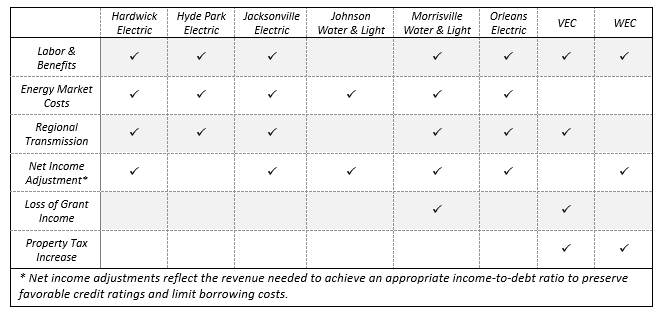As part of his anti-climate action campaign, the Governor has asserted that Vermont’s climate policies are recklessly driving up costs for Vermonters. This couldn’t be farther from the truth for Vermont’s 100% Renewable Energy Standard (RES). The update to the RES enacted last year was the product of careful collaboration between utilities and environmentalists, designed to make real reductions in climate pollution and limit the impact on rates. While it is true that Vermont’s electric rates are increasing, they remain the lowest in New England by a significant margin. The RES is entirely consistent with the kind of long-term, fixed-price, renewable energy contracts that have helped keep Vermont rates down. Recent rate increases have very little to do with Vermont’s climate policy and a whole lot to do with the forces that are driving up costs everywhere: increasing labor costs, rising insurance premiums, higher property taxes, and market fluctuations.
Since the updated RES became law in June of 2024, eight Vermont utilities have proposed rate increases to the Public Utility Commission; not one cites the RES as a primary driver of the proposed increases. The largest proposed increases came from five of Vermont’s smallest utilities, collectively serving 3% of Vermont households, and ranged from 10% – 25%. But while the topline numbers are eye-catching, they largely reflect the infrequency with which these smaller utilities update their rates. The Village of Jacksonville Electric Company, for example, is asking for a 25% rate increase, but this is the utility’s first rate adjustment since 2008, putting the proposed rate increase well below the cumulative rate of inflation for that period. In seven of these cases, the largest drivers of the cost increases the utilities are seeking to recoup are attributable to labor, insurance, and other factors like rising property taxes or loss of grant funding that have nothing at all to do with energy purchases or renewable energy policy.
Drivers of Proposed Rate Increases

Regional transmission costs and energy supply costs are the other contributors to increasing costs for Vermont utilities, but again, these cost increases are not closely related to Vermont’s renewable energy policy. Regional transmission costs are on the rise because of a growing number of asset condition projects by transmission companies throughout New England. Many of these projects are being built at a much higher cost than comparable transmission projects built in Vermont, and both VELCO and the Vermont Public Service Department have flagged that these projects should have greater oversight to ensure that they are not unduly affecting Vermont rate payers. Rising energy costs predominantly reflect changes in the wholesale price of electricity with several of Vermont’s smaller utilities taking a hit when a favorable five-year contract expired in 2024. These cost increases are situational, not universal; however. Other utilities reported a decrease in energy costs depending on fluctuations in the wholesale market and the timing of energy purchases.
Finally, it is worth highlighting that adapting to climate change is imposing a growing cost on utilities. VEC testified that “storms are more frequent and severe than they were five years ago” and stated that storm recovery expenditures totaled nearly $2 million from July 2023 through June 2024. In a rate case before the passage of the RES, GMP also stated that it was facing significant storm repair costs and had “experienced four of the ten largest storms in [its] history in the past year and a half.” In 2023, Washington Electric spent $1.3 million on repairs for a single storm, more than four times its annual budget for emergency storm management that year. These cost will only go up in the future.
What modest impact the RES may have on future rates, it is a fraction of the costs facing utilities and should not be an excuse for climate inaction.
